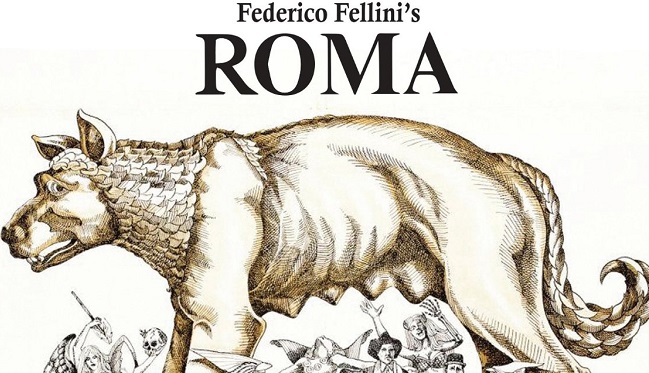
Disc Reviews
Roma Blu-ray Review
 Fellini’s Roma (also known simply as Roma) (1972) is the kind of arthouse film that is very much of its time. It is the Master’s love letter to his city. There is very little narrative in Roma, but is subtitled as ‘1931-1972: the Rise and Fall of the Roman Empire’. It is a series of loosely interconnected vignettes of the city beginning with 18-year-old Federico Fellini leaving his home town of Rimini and arriving in Rome in 1931 (although in actuality many have suggested that he must have arrived much earlier than this). In 1931 Italy had been under the dictatorship of Benito Mussolini for almost 10 years and the city is viewed in the eyes of the future director as a sin city. Cutting to 1972 it would appear little else has changed other than modernisation as Fellini’s camera follows people around the city: her congested streets, motorways and the re-development of a metro system (to rival that of Munich as one engineer states); in fact there are two very long, indeed tedious scenes of motorway traffic (recalling the opening sequence in 8½) and the tunnel construction whereupon the engineers and filmmakers stumble upon an underground treasure trove of murals and sculptures in an underground cavern, hitherto forgotten about. The faces stare back at you from the past one commentator states. Modern Rome seems to sit very uncomfortably with Ancient Rome and makes the city’s past all the more fragile.
Fellini’s Roma (also known simply as Roma) (1972) is the kind of arthouse film that is very much of its time. It is the Master’s love letter to his city. There is very little narrative in Roma, but is subtitled as ‘1931-1972: the Rise and Fall of the Roman Empire’. It is a series of loosely interconnected vignettes of the city beginning with 18-year-old Federico Fellini leaving his home town of Rimini and arriving in Rome in 1931 (although in actuality many have suggested that he must have arrived much earlier than this). In 1931 Italy had been under the dictatorship of Benito Mussolini for almost 10 years and the city is viewed in the eyes of the future director as a sin city. Cutting to 1972 it would appear little else has changed other than modernisation as Fellini’s camera follows people around the city: her congested streets, motorways and the re-development of a metro system (to rival that of Munich as one engineer states); in fact there are two very long, indeed tedious scenes of motorway traffic (recalling the opening sequence in 8½) and the tunnel construction whereupon the engineers and filmmakers stumble upon an underground treasure trove of murals and sculptures in an underground cavern, hitherto forgotten about. The faces stare back at you from the past one commentator states. Modern Rome seems to sit very uncomfortably with Ancient Rome and makes the city’s past all the more fragile.
Throughout Fellini’s oeuvre there is something of the carnivalesque, grotesque and caricature with the people in the director’s work. All the characters, other than the 18 year-old Fellini and some of the children are grotesques: there is the obese sweaty landlady lying on her bed, over made up street singers and the haggard looking and mostly buxom BBW prostitutes from the brothels. Other directors at the time were also filming such caricatures in Italian cinema, including Pasolini and Visconti, but none did it so over the top as Fellini. He is a very self-indulgent director, as evidenced in the self-portrait of the artistic filmmaker seeking inspiration in 8½ (titling a film with the director’s name in the title underscores this with the seemingly abstract title of this film being simply Fellini’s 8th film) with Fellini appearing and being referenced to in the film – taking the French idea of auteur to extreme lengths. He also has Italian cinema icons Anna Magnani and Marcello Mastroianni (star of many a Fellini film) appearing as themselves, but this scene ended up on the cutting room floor.
The two most memorable scenes in the film come towards the end with the parade of prostitutes from the brothel in front of potential johns touting for business in front of the drop-jawed men. These women are over made up, parading their ample flesh as if they have stepped out of a Rubens painting and look old and worn. By contrast the following scene has an ecclesiastical fashion display with roller skating priests, dancing nuns and bishops with lit up neon cassocks. This is a scene I am sure Luis Bunuel would have envied. Side by side the director is demonstrating that there is not a lot of difference between both these scenes and sets of social characters.
At times this is not an easy film to watch but many hold this up to be a masterpiece of Italian cinema and most certainly an honest bare all tribute to a city, even if it’s not an idealised or romanticised one. This is a re-release of a previous Eureka! Masters of Cinema release of the film with extras that include deleted scenes (totalling about 17 minutes), Italian and English language trailers and an introduction by Chris Wagstaff.
Chris Hick



